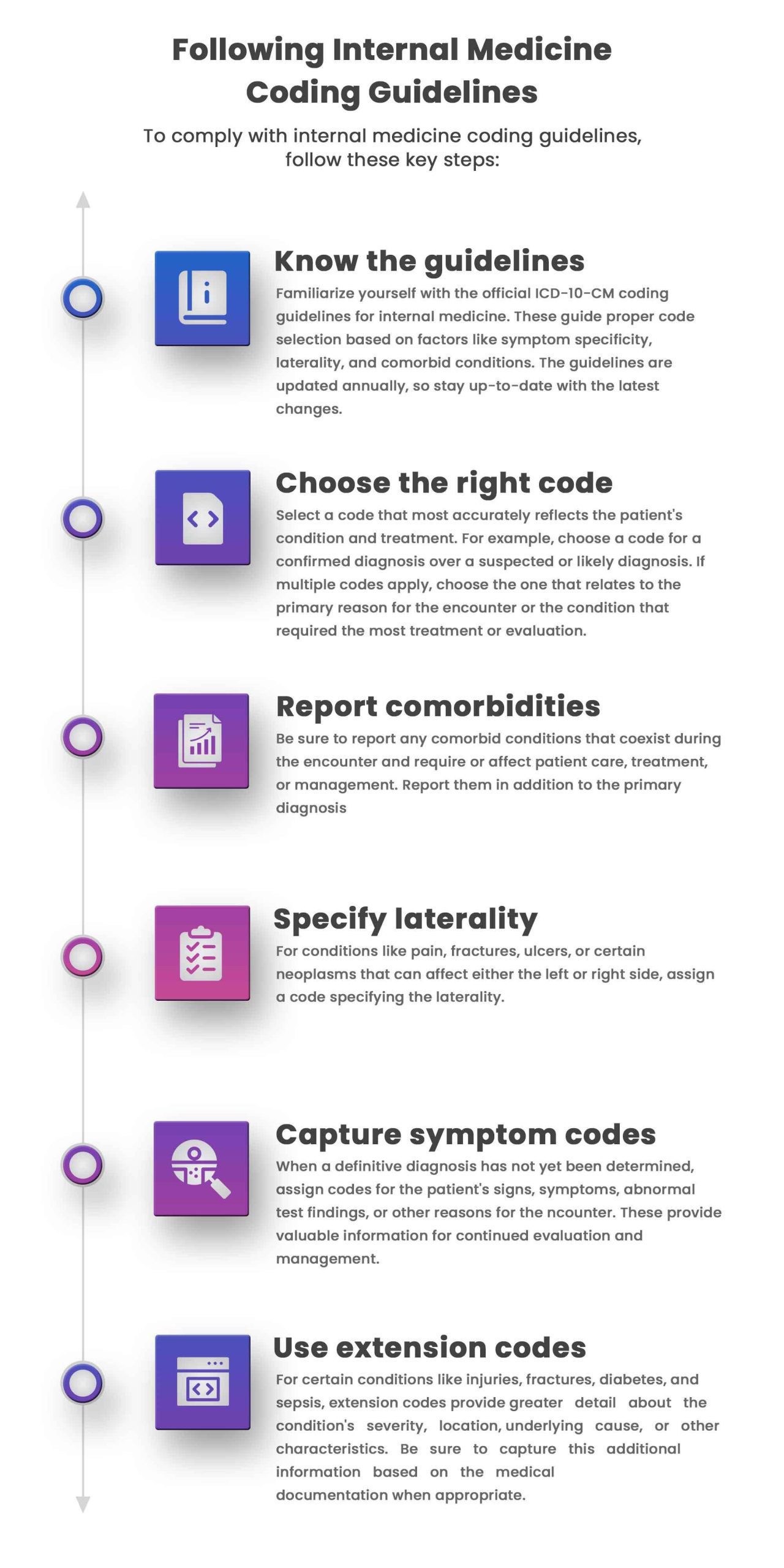Table of Contents
Toggle- Overview
- What Is Internal Medicine Coding?
- Common Internal Medicine Billing Codes
- Diagnosis Coding Tips for Internal Medicine
- Procedures Commonly Coded in Internal Medicine
- Strategies to Improve Your Internal Medicine Coding
- Importance of Documentation in Internal Medicine Coding
- Your Top Questions Answered (FAQs)
Overview
You know the drill. A patient comes in with a complex set of symptoms you diagnose and treat, then must document every detail to get paid properly for your services. Coding for internal medicine is challenging but essential. If you don’t capture the right codes, you could face penalties or miss out on revenue that keeps your practice running.
But don’t worry, we’ve got you covered. In this post, we’ll break down the keys to internal medicine coding compliance so you can focus on practicing medicine without hassle or worry. We’ll show you how to select the proper E/M codes based on medical decision-making and face-to-face time. We’ll decode common internal medicine procedures and the right modifiers to use. And we’ll highlight the documentation requirements to prove medical necessity if you get audited.
Stick with us; by the end, you’ll be coding confidently and building a compliant practice you can be proud of. No more guessing, no more gotchas – just the inside scoop on how to code right the first time, every time. Are you ready to become a coding master? Let’s dive in!
What Is Internal Medicine Coding?
Internal medicine coding refers to the process of assigning medical billing codes to patient encounters and procedures for internal medicine physicians. As an internal medicine coder, you review patient medical records and determine the appropriate code for each diagnosis, symptom, test, and treatment.
To become proficient in internal medicine coding, you must understand medical terminology, anatomy, and physiology. You must also be well-versed in the coding systems used, like the ICD-10-CM diagnosis and CPT procedure codes.
Staying Up to Date
The codes and rules for internal medicine coding are constantly changing. It’s critical that you stay up to date with the annual code updates and changes to coding guidelines. You should regularly review bulletins from the AMA and CMS.
Attend webinars or in-person training to learn about new codes and refresh your understanding of existing ones. Outdated knowledge could lead to claim denials or compliance issues.
Pay Attention to Detail
You must have a meticulous and methodical approach as an internal medicine coder. Carefully review each patient record, paying close attention to the physician’s documentation regarding symptoms, test results, diagnoses, and treatments.
Note all services are provided, and the most appropriate codes are determined based on the care level. Double-check that your selected codes comply with the official ICD-10-CM, CPT, and CMS guidelines before finalizing the claims.
Minor errors could delay payment or lead to take-backs, so precision and accuracy are paramount. With regular practice, attention to detail will become second nature.
Mastering internal medicine billing and coding takes continuous learning and dedication. But for those with the right mindset, it can be a rewarding career helping physicians get paid properly for their care. Keep your knowledge and skills sharp, follow the rules, and maintain high standards of accuracy, and you’ll excel as an internal medicine coder.
Common Internal Medicine Billing Codes
You must know the common codes and modifiers to properly code internal medicine services. Some of the frequent evaluation and management (E/M) codes you’ll use are:
99201-99205: Office/Outpatient Visit, New Patient
For a new patient’s initial visit, choose the code based on the complexity of the visit. 99201 is used for a straightforward visit, while 99205 is for a highly complex initial visit.
99211-99215: Office/Outpatient Visit, Established Patient
Choose a code for follow-up visits with existing patients depending on the complexity. 99211 is a general visit, 99214 is moderate complexity, and 99215 is highly complex.
You’ll also use various modifier codes to provide more details, such as:
- 25: Significant, separately identifiable evaluation and management service by the same physician on the same day of the procedure or other service.
- 57: Decision for surgery.
- 24: Unrelated evaluation and management service by the same physician during a postoperative period.
Proper coding depends on documenting the key components: history, exam, and medical decision-making. Remember to capture the patient’s complaints, symptoms, and medical history. Note your review of systems and any diagnoses or treatment options discussed. An accurate account of services provided will ensure correct coding and compliance.
With regular practice, these internal medicine codes will become second nature. But when in doubt, always refer to the official CPT codebook and payer guidelines. Precision and attention to detail are key to mastering medical coding.

Using E&M Codes for Office Visits
Using the appropriate E&M codes for office visits is key to compliance and maximizing reimbursement. When coding office visits, you’ll use one of the five major E&M codes:
99201-99205: New Patient Office Visits
For initial encounters with new patients, choose from 99201 to 99205 based on the level of complexity. 99201 is used for a straightforward visit, while 99205 is for a highly complex visit that includes a comprehensive history and exam.
99211-99215: Established Patient Office Visits
For subsequent encounters with established patients, choose from 99211 to 99215. Again, the higher the number, the higher the complexity and intensity. 99211 is used for a minimal problem-focused visit, typically just a blood pressure check. 99215 is for a detailed visit addressing several chronic illnesses and management options.
When determining the appropriate code, consider these key components:
- History: Review of systems, chief complaint, history of present illness. The more systems reviewed and the longer/more complex the history, the higher the code.
- Exam: General multi-system exam or focused organ system exam. 99205 and 99215 require comprehensive exams of eight or more organ systems.
- Medical Decision Making: Consider the number of possible diagnoses or management options, the amount/complexity of data reviewed, and the risk of complications. Higher codes require moderate to high complexity medical decision-making.
- Time: Though not the sole factor, higher codes typically have longer face-to-face time with the physician. 99205 is 40-54 minutes, while 99215 is 30-39 minutes.
By understanding the requirements for each E&M code and accurately capturing the key components of the patient encounter, you’ll code office visits correctly and ethically the first time. Be sure to document thoroughly in the medical record to support your code selection. If audited, the details in your documentation can make a difference in claim approval.
Mastering E&M coding for office visits is essential for any internal medicine practice. With time and experience, choosing the right code will become second nature.
Diagnosis Coding Tips for Internal Medicine
As an internal medicine coder, accurate diagnosis coding is key to compliance. Some tips to keep in mind:
1. Focus on Specificity
Choose the most specific code possible based on the documented symptoms and test results. For example, code J44.1 (Chronic obstructive pulmonary disease with exacerbation) rather than just J44 (Other chronic obstructive pulmonary disease). More specific codes provide a more accurate medical record and help with proper reimbursement.
2. Link Codes When Appropriate
If two or more diagnoses equally meet the criteria for being the primary reason for the visit, you may need to link them with a hyphen. For example, I10 (Essential hypertension) and E11.9 (Type 2 diabetes mellitus without complications) could be linked to I10-E11.9. Ensure the diagnoses are related and documented as equally contributing to the encounter.
3. Watch Out For V Codes
V codes indicate a patient is at risk for or has a history of a medical condition. For example, V15.82 (History of tobacco abuse) or V12.51 (Personal history of coronary angioplasty). These codes should not be used as a primary diagnosis. Only choose a V code when there is no current manifestation of the medical condition.
4. Review Past Medical History
Look for any diagnoses, symptoms, or abnormal test results documented in the patient’s medical history that are relevant to the current visit. Past conditions that continue to require or affect patient care should be coded. For example, chronic conditions like diabetes, COPD, or congestive heart failure. Coding chronic conditions at each visit provides a complete patient medical record.
5. Ask For Clarification
If you have questions about a diagnosis, symptoms, or test results or are unsure of the appropriate code, ask the physician for clarification. It’s always better to ask the doctor for more details than to make assumptions that could lead to improper coding. Building a good relationship with physicians leads to more accurate coding and compliance.
These tips will help you choose the most appropriate and compliant diagnosis codes for internal medicine encounters.
Procedures Commonly Coded in Internal Medicine
Internal medicine physicians perform various procedures, from the simple to the complex. Some of the most common procedures you’ll likely code for include:
Venipuncture
Drawing blood is a routine part of most patient visits. Bill for venipuncture using CPT code 36415. You’ll also want to code for any ordered blood tests or panels. Ensure your documentation clearly states that blood was drawn, the site it was drawn from, and what tests were requested.
IV Line Placement
Placing an intravenous (IV) line is also common, whether for administering fluids and medications or to draw blood. Use CPT code 36556 for IV line insertion in patients 16 and over. For pediatrics, use 36568. As always, document the catheter gauge and insertion site gauge.
Injections
Injections like corticosteroid injections, trigger point injections, and joint injections are frequently performed in internal medicine. Be sure to code based on the specific substance injected and the number of injections. Also, note if imaging guidance was used.
Wound Care
Cleaning, debriding, packing, and bandaging wounds are typical procedures for internal medicine physicians. Use the appropriate CPT codes from the wound care and debridement section based on the level of depth and complexity. Clearly describe the wound, tissues involved, instruments used, and dressings applied.
Pulmonary Function Testing
If your practice performs pulmonary function testing, there are multiple CPT codes to report the specific tests, such as spirometry (94010) or lung volumes (94220). Technical measurements and patient diagnoses should be well documented.
Internal medicine encompasses a wide range of conditions, so your procedures can vary greatly based on your patient population and practice focus. The most important thing is to accurately understand the requirements for reporting each procedure. Frequent coding updates, ongoing education, and close attention to documentation will set you up for success.
Strategies to Improve Your Internal Medicine Coding
To improve your internal medicine coding and ensure compliance, follow these proven strategies:
Focus on Specificity
Choose the code that most specifically identifies the patient’s condition or procedure. Do not code nonspecifically or for a symptom when the underlying diagnosis is known. For example, code diabetes mellitus instead of polyuria or polydipsia.
Review Medical Records Thoroughly
Read the entire medical record to understand the patient’s condition and diagnosis. Look for complicating conditions and secondary diagnoses that could impact code selection. Check for conditions that were monitored, evaluated, or treated. Code all documented conditions that coexisted at the time of the encounter.
Ask for Clarification
Ask the physician to clarify before coding if any part of the medical record is unclear or conflicting. It is better to delay coding to obtain clarification than to code incorrectly. Physician clarification will result in the most appropriate and compliant code selection.
Stay Up-to-Date with Coding Guidelines
Coding guidelines are updated annually. Review the guidelines for internal medicine to ensure you understand any changes that could impact your coding. Guidelines clarify the correct use of certain codes and specify when multiple coding is required or allowed. Following the official ICD-10-CM guidelines is essential for accurate and compliant coding.
Conduct Regular Self-Audits
Perform periodic self-audits of your internal medicine coding to identify areas needing improvement. Check that you are selecting the most appropriate codes, all diagnoses are being captured, and guidelines are being followed properly. Self-auditing is key to continual progress and maintaining high-quality work.
Ask a Coding Professional for Guidance
If you have a complex case or coding question, ask an experienced coding professional for guidance. Discussing coding scenarios with others helps reinforce your own understanding and can uncover alternative considerations. Seeking guidance when unsure will boost your confidence in code selection.
Following these practical strategies will strengthen your internal medicine coding skills, support compliance, and ensure accurate reimbursement. Continuous learning and improvement are key to mastering medical coding.
Importance of Documentation in Internal Medicine Coding
Accurate and thorough documentation is essential for compliance in internal medicine coding. As an internal medicine coder, you must understand the specific documentation required to support the codes you’ve chosen.
To code accurately for an encounter, you need to understand the patient’s chief complaint, history of present illness, review of systems, physical exam, medical decision-making, and treatment plan. The more details the physician includes, the easier it will be for you to choose the correct codes. Ask for clarification from the physician if anything is unclear or missing in the documentation.
It’s important to note that simply re-stating what the physician has documented word-for-word is not acceptable. You must interpret the physician has written and translate that into the proper ICD-10 and CPT codes based on official coding guidelines. Some key things to look for in the documentation include:
- The patient’s symptoms and conditions
- Specific diagnoses and comorbidities
- Tests and procedures ordered
- Treatment plans and follow-up care
Choosing the right codes is challenging, but thorough documentation makes the process much easier. If the documentation lacks important details, you risk choosing codes that do not accurately reflect the complexity of care provided. This can negatively impact reimbursement and compliance.
It is key to building a good relationship with physicians and educating them on proper documentation and coding requirements. Offer to provide physicians feedback on their documentation to help improve it over time.
While coding software and references can assist in the process, human judgment is still required. Your knowledge, experience, and understanding of documentation requirements for internal medicine services are essential to achieving the highest degree of accuracy and compliance possible. Maintaining a commitment to continuous learning and improving documentation review skills is key to success as an internal medicine coder.
Your Top Questions Answered (FAQs)
As an internal medicine coder, you likely have questions that come up on the job. Here are some of the most frequently asked questions and answers to help you in your role.
What are the most common diagnoses for internal medicine?
Some of the most common diagnoses you’ll code for internal medicine include:
- Hypertension (High Blood Pressure)
- Type 2 Diabetes
- Hyperlipidemia (High Cholesterol)
- COPD (Chronic Obstructive Pulmonary Disease)
- Asthma
- Upper Respiratory Infections (Like Bronchitis)
- Gastroesophageal Reflux Disease (GERD)
- Thyroid Disorders
What CPT codes are used most often?
For internists, some of the most frequently used CPT codes are:
- 99214 – Office/Outpatient Visit, Moderate Severity
- 99213 – Office/Outpatient Visit, Low to Moderate Severity
- 99203 – Office/Outpatient Visit, New Patient, Moderate Severity
- 77056 – X-Ray Exam, Chest, 2 Views
- 80048 – Metabolic Panel (Blood Chemistry)
- 99204 – Office/Outpatient Visit, New Patient, Moderate to High Severity
- 99212 – Office/Outpatient Visit, Self-Limited or Minor
What are the documentation requirements for E/M services?
For evaluation and management (E/M) services like office visits, be sure the physician documents:
- Chief Complaint (CC)
- History of Present Illness (HPI)
- Review of Systems (ROS)
- Past Medical, Family and Social History (PFSH)
- Physical Exam (PE)
- Medical Decision Making (MDM)
- Assessment, Clinical Impression or Diagnosis
- Plan of Care
The extent of HPI, ROS, and PFSH and the complexity of MDM determine the level of E/M service. Specific, detailed documentation is key to proper coding and compliance for internal medicine.











